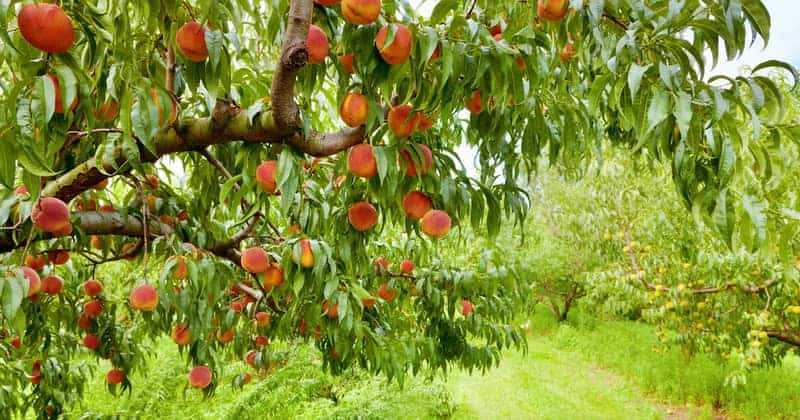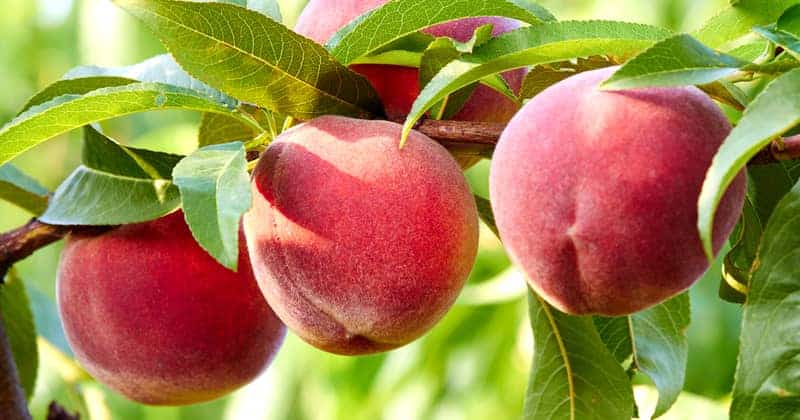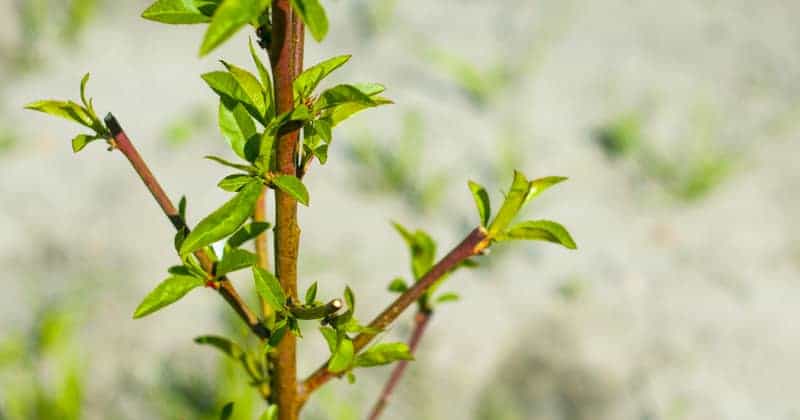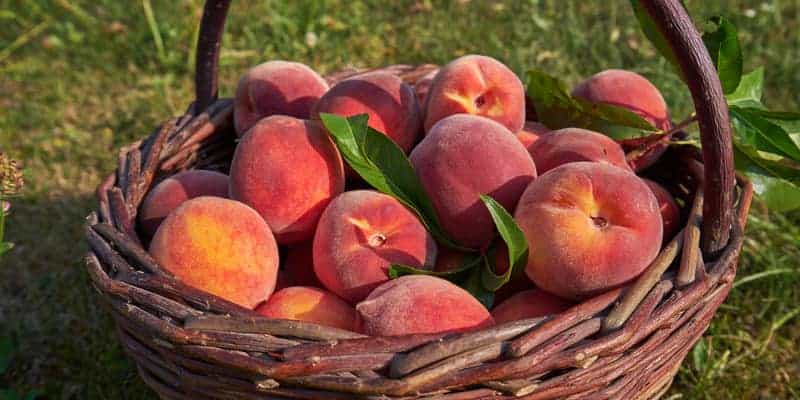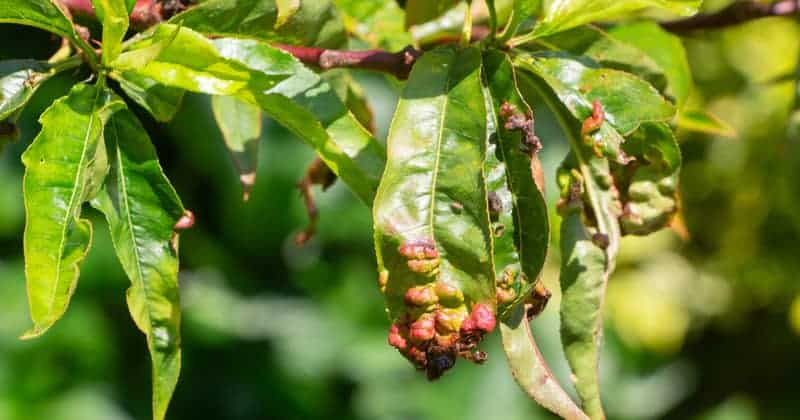A wise turtle once said that no matter what you do, your peach seed will grow into a peach tree. You may wish for an apple or an orange, but you will get a peach.
We don’t know about you, but we wouldn’t wish for our peach tree to be anything else.
Growing a peach tree is straightforward – and yes, you can grow peaches from seed! The easiest way is from bare root trees, however. Simply dig a planting hole in a sunny spot – preferably slightly elevated. Dig a hole the same depth as the tree’s root ball and place the young tree in gently. Water well, and consider organic mulch to retain moisture.
Ready to grow a peach in a pinch? Here’s how to plant a peach tree so you can enjoy all the fruits you want.
Peach Tree Growing 101
There’s a lot to know before growing a peach tree, but don’t worry! We’ll break the info down for you easy-peachy. (Ha!)
Peaches grow to approximately 4m tall, while their dwarf forms can reach 1.5m. They grow faster than other stone fruit trees, but don’t last as long – their lifespan is only 10–12 years.
Besides the peach-coloured fruit and white-pink flowers, peach trees are distinctive for glossy-green leaves. The foliage turns yellow in the fall before dropping in winter.
Peaches vs nectarines
Both the peach and the nectarine are the same species: Prunus persica. Nectarine fruit has no fuzz and is smaller than the peach. Sometimes, though, your peach tree may go rogue and produce nectarines – take it as a happy bonus!
(Fun fact: professional growers control their crops through a grafted tree. They take nectarine branches then graft them onto peach trees!)
Is a peach tree poisonous?
Yep! Apart from the fruit, all parts of the peach tree are toxic to both humans and pets. Don’t let any furry friends get at fallen leaves!
When to plant peach trees?
Peaches are best planted in late winter or early spring. This means it has the entire growing season to establish itself and begin maturing.
What’s the best soil for peaches?
Peaches need sandy, well-drained soil to thrive. Moderately fertile soil enriched with organic matter will encourage more fruiting. Ideally, the soil pH is between 6 and 7.
How much sun do peaches need?
Keep your peach tree somewhere with full sun – but keep them out of the wind!
What climate is best for peach trees?
Peaches thrive better in temperate regions since they need “chill hours” – cold temperatures for a certain amount of time – to develop fruit. There are “low-chill” peach varieties that are adapted to warmer climates, though!
How do you water a peach tree?
Water a young tree regularly until it has matured. When the tree has established itself, it is quite drought-tolerant, although you should water extra during flowering or dry seasons.
How to Grow a Peach Tree
Choose a peach variety that’s appropriate for your local climate and environment. You can consult your local nursery for advice. Once you’ve acquired a young tree, it’s time to plant!
- Choose a slightly elevated spot in full sun as a planting site.
- Dig a planting hole wide enough to let the tree’s roots spread.
- Lower the root ball into the ground and backfill the hole.
- Firm down the soil gently.
- Set up a stake next to the tree, about 30cm deep. Affix the tree to the stake.
- Spread some mulch around the root zone.
- Keep the soil moist while the tree matures.
After that, wait for your tree to reach around 1.5m, then prune it down to 1.0m tall. This encourages young trees to form fruiting wood. Then wait for your tree to grow and bear fruit!
How to Plant Peach Trees from Seed
Only grow peaches from seed if you’re willing to wait more than 2 years. They take longer to bear fruit, but can be well worth the effort.
- Crack open the peach pit and remove the kernel.
- Place the peach kernel in a plastic bag filled with moistened potting soil.
- Seal the bag and keep it in the refrigerator.
- Check the seed for germination after 2–3 months.
- Once the tree has a root system that’s 1.5cm long, remove the kernel from the fridge.
- Plant the seedling in a small container.
- Keep the container in a sunny location and keep the soil moist.
- Plant outdoors in early spring, once there’s no more frost.
Harvesting peaches
Few things are as delectable as fresh peaches. One of the joys of owning a tree is when you harvest peaches, then bite into the juicy fruit. This deciduous tree blooms in gorgeous pink flowers during the spring. Following that, you’ll get small green fruits.
Many of these tiny peaches will drop naturally, although you should also thin your crop. Remove all fruits except the largest, with at least six inches between each. The remaining fruit will grow into delicious, fresh peaches.
Peach Tree Care
Peach trees are pretty hardy, but they still need proper care to make sure they’re healthy. This includes regular pruning, watching for diseases, and minding the fruit production!
Pruning peach trees
Good pruning ensures fruit-bearing branches receive enough light. This will let them grow healthy-sized peaches for harvest time. Prune your peach tree in late winter, although you can do some light shearing in summer if your tree is overgrown.
The ideal branch pattern is a herringbone with an open centre – essentially an open vase shape. If this is confusing, don’t worry – an expert pruning service will help with that!
Peach borer
This is the most common and significant of peach pests. A peach tree borer is a clearwing moth that resembles a wasp. In autumn, it will deposit eggs on the tree bark, which then hatch into grubs. These grubs will burrow into the trunk to eat the wood and roots.
Symptoms of peach borer include jelly-like sap around holes in your tree. Organic neem oil in a high concentration works as a preventative, especially during the breeding season. Citrus extract sprays also deter adult insects from laying eggs in your tree.
Peach leaf curl
Certain fungi can cause peach leaf curl. If your leaves have a slight twist or brown rot showing, that’s a sign that a fungus has attacked your tree. A copper-based fungicide used in late fall or early spring can control this disease.
Fruit production
You may experience several problems while growing peaches. For example, if it doesn’t bear fruit yet, it could still be too young. Peach trees anywhere between 2–4 years to produce fruit, depending on how you planted them. Other reasons for a lack of fruit production include:
- Too much nitrogen
- Over-pruning
- Few pollinating insects
If your concern is a lack of tree partners, you don’t need two peaches for fruit! Peach trees are self-pollinating, so only one tree is necessary.
Meanwhile, premature fruit drop is caused by:
- Excess fruit production
- Late frost or excessively cold weather
Take care of your peach tree, and you won’t have to worry about any of these issues. Prunus persica is hardier than you think, and will bring you plenty of benefits. Have you ever tried a peach mango pie? If you haven’t – now’s the time to learn how to grow a peach tree, and give it a go!



